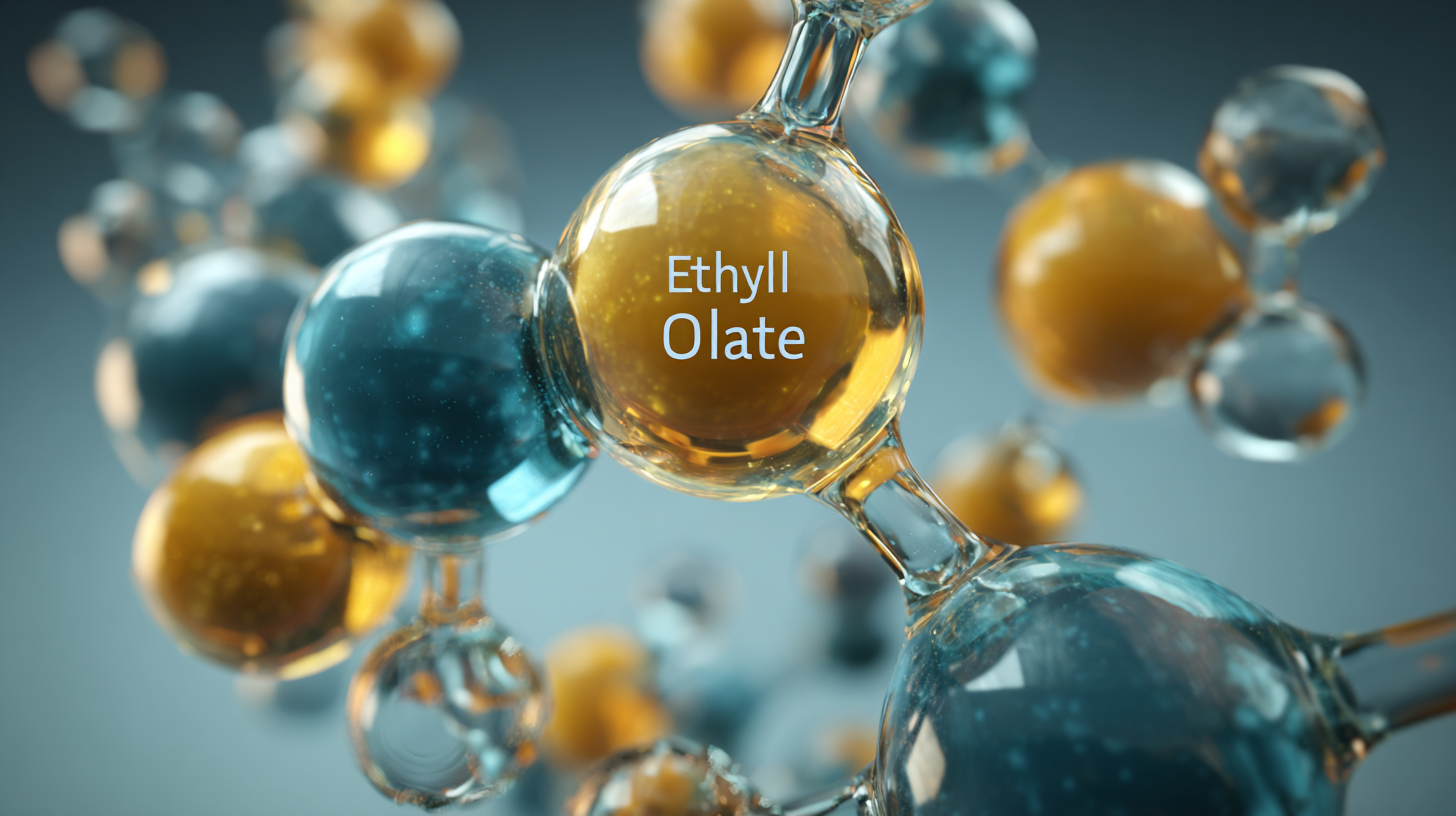
News
Exploring the Future of Best Ethyl Oleate in 2025 Technological Advancements and Market Insights
As we look ahead to 2025, the landscape for Ethyl Oleate is set to undergo significant transformation driven by rapid technological advancements and evolving market dynamics. According to a recent report by Grand View Research, the global ethyl oleate market is projected to reach USD 1.5 billion by 2025, exhibiting a compound annual growth rate (CAGR) of 4.2% from 2019 to 2025. This growth is spurred by the increasing demand for bio-based solvents and formulations in various industries, including pharmaceuticals and cosmetics, where Ethyl Oleate is lauded for its emulsifying properties and versatility. As industry stakeholders adapt to the shifting trends, this blog will delve into the expected developments, key innovations, and market insights that will shape the future of Ethyl Oleate in the coming years, providing a comprehensive guide on how to navigate this dynamic sector effectively.

Ethyl Oleate: A Key Player in the Future of Biochemical Innovations
 Ethyl oleate is gaining attention as a pivotal component in the realm of biochemical innovations, especially as we look toward 2025. This versatile ester, derived from oleic acid and ethanol, has established itself as an essential ingredient in various applications, including pharmaceuticals, cosmetics, and even food industry formulations. Its unique properties, such as biocompatibility and ability to serve as a solvent and emulsifier, make it an attractive option for both manufacturers and consumers alike.
Ethyl oleate is gaining attention as a pivotal component in the realm of biochemical innovations, especially as we look toward 2025. This versatile ester, derived from oleic acid and ethanol, has established itself as an essential ingredient in various applications, including pharmaceuticals, cosmetics, and even food industry formulations. Its unique properties, such as biocompatibility and ability to serve as a solvent and emulsifier, make it an attractive option for both manufacturers and consumers alike.
As technological advancements continue to shape the landscape of biochemical development, ethyl oleate is positioned to play a crucial role. The ongoing research into its applications is paving the way for innovative solutions, such as enhanced drug delivery systems and more efficient manufacturing processes. With a focus on sustainability and eco-friendly practices, the production of ethyl oleate is also being optimized, driving its adoption as a greener alternative in chemical synthesis. The future looks promising for this compound, as it merges science and sustainability to revolutionize various industries.
Technological Advances Driving Ethyl Oleate Production Efficiency
The advancements in ethyl oleate production are set to reshape the industry by 2025, driven primarily by breakthroughs in enzymatic synthesis and sustainable practices. Notably, recent studies highlight the use of lipase immobilized on PDMS-modified nonwoven viscose fabrics in a solvent-free system. This innovative approach enhances the efficiency of the esterification process, allowing for more sustainable production of ethyl oleate, a crucial component in biodiesel and biolubricants.
As the demand for renewable energy sources increases, the integration of engineered microbial platforms has become a focal point. These platforms not only improve production yields but also enable the conversion of various feedstocks into high-value biochemicals. It has been reported that biodiesel production from fatty acid ethyl esters shows significant potential, particularly when utilizing advanced catalysts and optimized feedstocks.
Tips:
- Explore partnerships with research institutions to leverage cutting-edge technologies in your production processes.
- Stay updated on regulatory changes regarding biodiesel and biobased products to ensure compliance and market competitiveness.
- Consider investing in R&D focused on microbial engineering for enhanced product diversification in the biofuel sector.
Market Trends Shaping the Demand for Ethyl Oleate by 2025
The demand for Ethyl Oleate is set to witness significant growth by 2025, driven by advancements in technology and evolving market trends. As the oleate esters industry is projected to surpass USD 2.6 billion by 2034, with a CAGR of 4.1% from 2025, it indicates a robust upward trajectory. Factors contributing to this growth include a rising preference for natural ingredients in personal care and cosmetic applications, as well as the increasing adoption of Ethyl Oleate as a solvent and emollient in various formulations.
To capitalize on these trends, manufacturers should consider investing in sustainable production methods and innovative applications of Ethyl Oleate, particularly in the beauty and skin care sectors. The recent shift towards plant-based and eco-friendly products positions Ethyl Oleate favorably among consumers who seek greener alternatives.
Tip: Businesses should keep an eye on technological advancements in manufacturing, as the right machinery and processes can greatly enhance production efficiency. Additionally, understanding the regulatory landscape will be crucial to navigate new market opportunities effectively. Engaging in market research to stay updated on consumer preferences can further sharpen a company's competitive edge in this evolving industry.
Sustainability Practices in Ethyl Oleate Manufacturing: A Future Perspective
The ethyl oleate market is poised for significant transformation as sustainability practices become increasingly paramount in manufacturing processes. In 2025, reports indicate that over 70% of consumers will prefer products from companies that adopt eco-friendly practices, creating a pressing demand for sustainable manufacturing solutions in the cosmetic and pharmaceutical industries where ethyl oleate is widely utilized. According to a recent market analysis, the global ethyl oleate market is projected to reach USD 50 million by 2025, largely driven by this shift toward sustainable sourcing and production methods.

Manufacturers are now focusing on reducing their carbon footprints through innovative processes such as green chemistry and waste minimization. For instance, utilizing biomass sources for ethyl oleate production not only lowers greenhouse gas emissions but also aligns with the growing trend of circular economy practices. Industry statistics show that adopting these sustainable practices can reduce operational costs by up to 30%, making it financially viable for companies to invest in greener technologies. As we look to the future, it’s clear that sustainability will not only drive compliance and consumer loyalty but also enhance profitability within the ethyl oleate industry.
Application Innovations: Ethyl Oleate in Pharmaceuticals and Beyond
Ethyl oleate, a prominent fatty acid ester, is becoming increasingly valuable across various sectors, especially in pharmaceuticals. Its unique properties, such as excellent solubility and ability to enhance drug bioavailability, enable it to act as an effective solvent and carrier for many therapeutic compounds. In 2025, we anticipate significant technological advancements will further augment its application in drug formulation. Innovations like microencapsulation and nanotechnology are expected to optimize ethyl oleate's compatibility with a broader range of active pharmaceutical ingredients, making treatments more effective and targeted.
Beyond pharmaceuticals, ethyl oleate is finding new roles in the cosmetic and food industries. Its emulsifying and stabilizing properties make it an ideal ingredient in skincare products, enhancing texture and extending shelf life. As consumer demand shifts towards natural and effective ingredients, formulations containing ethyl oleate are likely to gain popularity. Moreover, its applications in food products as a flavor carrier and preservative can increase, driven by the trend for cleaner label offerings. The exploration of ethyl oleate's versatility in these markets highlights an exciting future filled with possibilities for both manufacturers and consumers alike.
Exploring the Future of Best Ethyl Oleate in 2025: Technological Advancements and Market Insights
| Year | Application Area | Market Size (in Million USD) | Growth Rate (%) | Technological Innovation |
|---|---|---|---|---|
| 2025 | Pharmaceuticals | 500 | 12 | Enhanced Drug Delivery Systems |
| 2025 | Cosmetics | 300 | 10 | Sustainable Sourcing |
| 2025 | Food Industry | 250 | 8 | Natural Preservatives Development |
| 2025 | Industrial Applications | 150 | 6 | Biodegradable Solvents Innovations |
| 2025 | Agriculture | 100 | 5 | Natural Pesticide Formulations |





